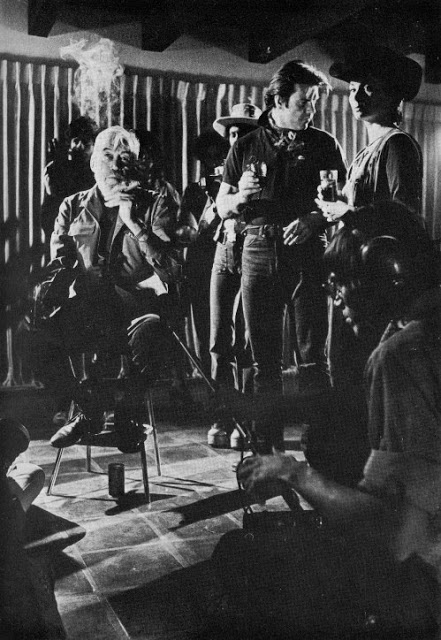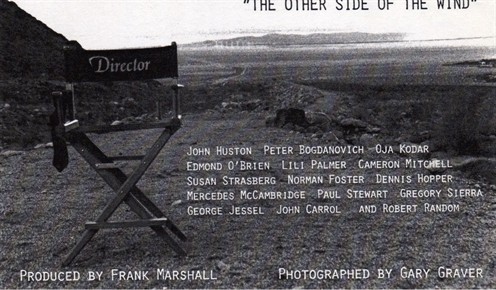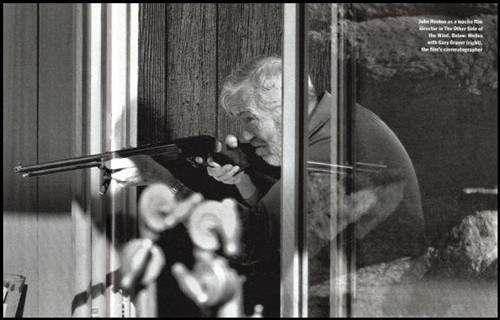
This film's structure doesn't resemble
that of any other film made to date. In fact, what we have here are
two films running at the same time, sometimes even
simultaneously.
Regarding the first of these
films:
It is a documentary chronicling one
day in a man's life.
(There is no aspect whatsoever
about the dramatic arts -no matter how modest it might be- that
isn't based on certain rules or conventions. The filmmaker works
like a novelist. His point of view (POV) is God's point of view in
the sense that he intends to be omniscient and all knowing. The
premise is that he knows everything about the story and that what
he decides to tell viewers is a compendium of materials of his own
choice. In this film we adopt a new convention: we take God's eye
away from the filmmaker, or so it seems.
The first of our films (although
they make up a single movie) supposedly comprises the
documentary-like material that has been filmed and recorded during
the remaining hours of a man's life.
That man is J.J. Hannaford, known
to almost everybody as "Jake" Hannaford, even to the people who
have never met him, including the public.
Like Hitchcock, he was more than
just a name. Like Hemingway (who resembled him) he was, even if we
set his works aside, a world celebrity.
As a movie director he is one of
the few, amongst half a dozen or so, who seems to have found a
place for himself in history and who undoubtedly deserves to be
called a "great" filmmaker. As versatile as Hawks (though less
poetic), as poetic as Ford (though less sentimental), Jake
Hannaford belonged to their generation, although not really to the
same world. Like Rex Ingram (who has nearly been forgotten), Jake
was a vagabond. Most of the time, he worked as far away as possible
from California's studio world. He worked for Hollywood but took
his cameras with him all over the world. He preferred distant and
difficult places on earth because he found them more exotic. When
he wasn't in a big game hunting country, a frozen tundra or a
tropical jungle, the place he felt most at home was Spain (also
like Hemingway whom he resembled in so many ways).
His home in America was a ranch in
the desert, and it was there where the "documentary" material that
represents our portrait of him was filmed and recorded. It happened
on the occasion of a birthday party celebrated in his honor by one
of his oldest and most loyal friends: Zarah Valeska - that fabulous
"femme fatale" from the onset of movies with sound.
Zarah had decided that the time had
come for new people from Hannaford's profession to get to know and
talk to him. Naturally, the profession was filmmaking although to
him it was more an art than a profession even though there is no
evidence that suggests that he ever referred to himself as an
artist. Although he possessed a wide-ranging and deeply-rooted
culture, he was not the least pretentious or ostentatious. On the
contrary, he often acted is if he were practically illiterate.
Obviously, a man like him had to be in open contradiction to the
new generation of filmmakers who despise cinema as an "industry"
and only respect it when it aspires to be something more "serious"
than a mere entertainment.
The birthday party Zarah Valeska
organized for him was conceived as a confrontation between Jake and
the new filmmakers from a younger generation. In that regard -like
nearly all other aspects- the party was a failure.
[...] Just as two different plots
often unfold in one musical, this movie mixes two films in
counterpoint to each other.
As we have said already, the first
film is the documentary account of the last day of Hannaford's
life.

The second film is Hannaford's own
film, i.e. the one he was making before his death; it is shown
during the action of the other film. It is shown to Hannaford's
guests in the private screening room on his ranch. Those who watch
it are characters in the other film, the documentary history. Thus
the action in the first film is an integral part of the
"documentary."
But Hannaford's film takes on a
life of its own. It tells its own independent story.
In a way, each film is a comment
about the other.
Hannaford's film narrates the
simple story about a young man and a woman (it isn't necessary to
go into details about the story here) and is conceived like a sort
of dream. Jake himself would have rejected the word "surrealism,"
but we'll have to use it to describe his last film.
As a filmmaker he always took risks
and, quite frequently, he was openly experimental. He made many
popular films, but even the commercial productions contained an
element of search, a subtle inclination to move around unexplored
regions, to find new forms and new dimensions. He wasn't an
"artistic" director (he hated that kind of thing), he was, to put
it simply, an explorer by nature, a pioneer that rode ahead of
almost all the others, always close to the border.
His last film belongs to a kind of
cinema that is very new though made by an old director. It is an
experiment and a reflection of its author.
The hero and heroine in his film
find themselves, after a series of adventures, "camping" in what
was once a movie studio, amid the remains of Chinese villages,
Persian palaces and New York slums made of inpapier machémany years
ago for long forgotten movies. They both arrive at the end of their
own story in a strange, ghostly world were nothing is or ever has
been real, and where even the illusion of reality turns to
dust.

They have, in fact, arrived at the
ruins of Hollywood.
They have arrived at the end of
Hannaford's world.
At the very end (of it all),
Hannaford has a car crash and is set ablaze.
[...] Perhaps the biggest paradox
of this paradoxical man was that Hannaford might have, in the end,
reached the point of being bored of himself.
That simple fact might lie beneath
the mystery of his suicide… if he did indeed commit suicide.
[...] He was a man who wore many
masks. At his birthday party, journalists try to tear them off him.
But do they succeed? The real mystery perhaps is not to be found in
the cause of his death but, rather, in the character of the man
himself, in the final truth about the artist, the creator of masks
behind masks. If he did indeed say everything about himself through
his art, is there anything left to be said by anyone else about
him?
Hannaford was a creator of images,
images that take on a life of their own on the screen. Was there
anything behind such images, behind the screen? Anything that
really mattered in the final analysis… other than yet another
mask?
ORSON WELLES